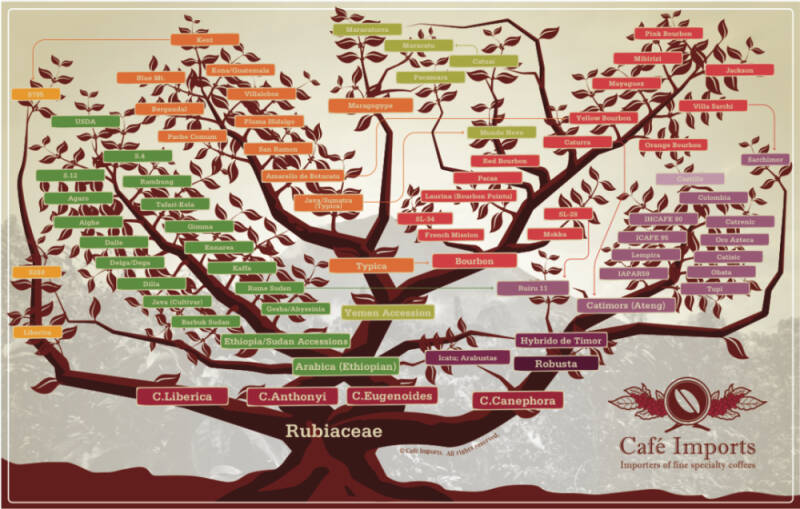Introduction of Katim Coffee Bean Variety Group, Coffee varieties and Yunnan small grains Katim

Coffee varieties can be divided into three categories: Arabica, Robusta and Liberica. With the development of the coffee industry, many varieties have been bred through continuous transplantation, mutation and mating. Kaddura (Caturra), Catuai (Catimor) and other well-known varieties are all mutated and hybridized. Bourbon, Kaddura and Kaduai coffee beans have been introduced earlier. Today, let's take a look at Katim, an artificial hybrid bred to resist leaf rust.

After hundreds of years, the cultivation of coffee has gradually spread all over the world. But in fact, each kind of plant has its own "regional adaptability". It still takes a period of adaptation time to move from its native place to other countries in order to survive. But it was not always plain sailing. In 1869, leaf rust began to invade Arabica coffee plantations, first in Asia, including estates in India, Java, Indonesia and Sri Lanka, all planted with iron pickup Typica.
When Europeans see Asian coffee farms affected by leaf rust, they also find ways to prevent it, that is, to replace new varieties, so they look for bourbon Bourbon. The French brought bourbon back to Brazil from the island of Reunion, and Brazilian coffee plantations were replaced in large numbers in 1870. During the time after planting, there was a mutation in bourbon due to adaptation to the American climate, resulting in the emergence of a variety Kaddura Caturra, and a mutant Vera Saatchi Villa Sache in bourbon planted in Costa Rica in 1950. When leaf rust came to America in 1970, it still affected Ironpickup and bourbon and its variants. And greatly reduce the production of coffee gardens in various countries, resulting in significant economic losses. So botanists from various countries began to study the use of scientific hybrids for disease resistance of new varieties.
In 1920, Timor Hybrid appeared on the island of East Timor, which is a natural cross between Arabica and Robusta. It belongs to Arabica coffee plant, but it has the disease resistance gene of Robusta. Therefore, the first generation of F1 hybrid group was produced by crossing Timor variety with Kaddura, which is now Katim Catimor.
Katim is only the first generation of cross between Kaddura and Timor, codenamed T8667, but it still needs to be determined by breeding, so Katim is not a variety, but a breed group with similar lineages. In addition, Timor crossed with another bourbon variety to become the Sachimo Sarchimor variety group, codenamed T5296. These varieties are particularly suitable for planting at an altitude of about 700-1000 meters, and are rapidly planted in American coffee plantations as a new variety with high yield, disease resistance and adaptability to warm climates at low elevations. Since the late 1980s, national coffee laboratories have begun to develop their own Katim subspecies.
Costa Rica T8667 and T5175 are selected by the Costa Rican Centre for Tropical Agricultural Research and higher Education (CATIE), which introduced F5 offspring bred by Portuguese H26 materials. T refers to the location of the institute, Turrialba. Another variety, Costa Rica95, was developed by the Costa Rican Coffee Institute (ICAFE) and released in June 1995.
Costa Rica95
The Katim variety developed in Honduras by the Honduran Coffee Institute (HCAFE), called Lempira, can grow at an altitude of 600-1000 meters.
Lempira
El Salvador is cultivated by the Salvadoran Coffee Institute (ISIC), called Catisic, and can be grown in acidic soil at an altitude of 600-1200 meters.
Catisic
Originally, tin trucks were grown in Yunnan. In the 1990s, Nestl é introduced Katim to Yunnan to produce instant coffee. For farmers, it is much cheaper to take care of Katim than a tin pickup, and it produces twice as much as Katim, resulting in a volume-based production mode. At present, Katim, Tieka, Bourbon, Kaddura and other varieties are also planted in Yunnan. However, Qianjie also has a small Katim coffee bean from Yunnan, washed and tasted with melons and fruits, with a little plum acid and cocoa flavor, black tea taste and overall balance.
Disclaimer: some of the pictures in this article come from the network, and some of the contents of the website, such as pictures, we will respect the origin of the original copyright, but due to the large number, there will be individual pictures and texts not in time to indicate, please forgive me. If the original author has any disputes can contact the website to deal with, once verified, we will immediately correct, by "Ka comment vdailycom" collation and editing, reprint please indicate, this article is intended to spread coffee culture, if infringement, please inform to delete, thank you ~!
Important Notice :
前街咖啡 FrontStreet Coffee has moved to new addredd:
FrontStreet Coffee Address: 315,Donghua East Road,GuangZhou
Tel:020 38364473
- Prev

Call 12315? Extraction for more than 40 seconds is complained?!
A ▲ Click to follow | Daily boutique Coffee Culture Magazine Coffee Workshop as a consumer, if you buy bad coffee, what do you usually do? In most cases, you choose to ask the store to redo or refund it. For example, coffee chains redo it for free after customer feedback is not good, and some independent coffee
- Next

Coffee prices have risen sharply, and research suggests that Liberica may be the next major coffee crop
Recently, the price of coffee futures has risen sharply, with the main contract price of Arabica futures breaking through 200 cents / lb, and the assistant contract price of Robusta coffee futures approaching 3000 US dollars / ton. According to the General Administration of Customs of Vietnam, Vietnam's total coffee exports fell 7.4% to 119297 in November compared with the same period last year.
Related
- Is espresso stored overnight in the refrigerator harmful to your body? Is frozen coffee better than freshly ground coffee?
- What parameters and proportions of water temperature should be used to grind and brew fresh coffee beans? Why can't I drink freshly roasted coffee right away?
- Customers have "changed" Manner's new products! Shop assistant: Please don't mess around!
- Remove sockets in customer areas at Starbucks stores?! Netizen: I won't go if I really tear it down
- What is the difference between the taste steps of sun-dried coffee and washed coffee? Why is sun-cured coffee sweeter and washed coffee sour?
- The recipe for salty grapefruit dirty is revealed! Coffee Festival salty grapefruit dirty coffee making materials parameters ratio milk share!
- How about the flavor of Sunlight 74158 at Sidamo Banshaha Mathieu Processing Factory in Ethiopia? 74158 Share the proportion of coffee brewing parameters!
- What effect does Italian American coffee with filter paper have? Will coffee taste better if it is put on filter paper at the bottom of the powder bowl?
- What is the color difference in coffee beans? What are the characteristics of honey processed coffee beans? Why are the anaerobically treated coffee beans uneven in color?
- How does novice Xiaobai quickly get started and make coffee? Newbies learn to make coffee by hand and share the specific steps and process process!

